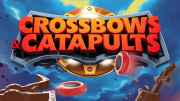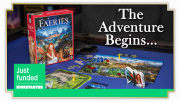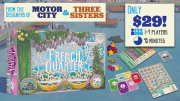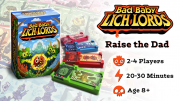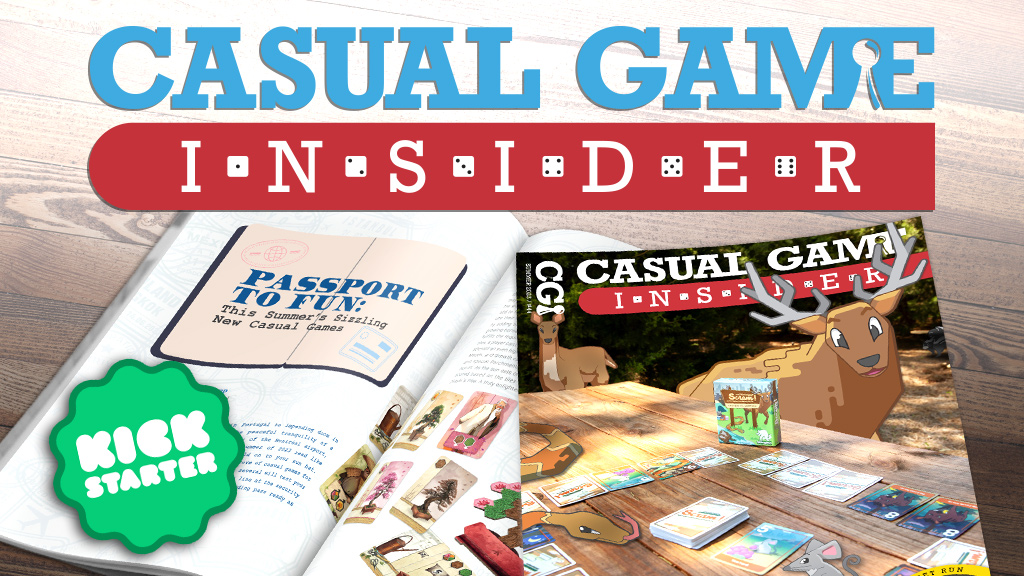Adventure Party: The Role-Playing Party Game (Smirk & Dagger Games) – In this role-playing party game, players take turns being the game master. The game master reads the event card. The player next to him secretly rolls his 20-sided die and then chooses one of his two magical items to use in response to the event. Based on the item and his roll, the player describes what happens. The game master may ask one clarifying question and then everyone guesses what they believe the player rolled based on his description. The closer the guesses to the roll, the more points the group earns. The role of game master then rotates, with a new event picking up where the story left off after the player's action.
Casual Game Crowdfunding: Role-Playing, Rabbits, and Remakes

This month brings a party role-playing game to Kickstarter, as well as a remake of a classic 1980’s board game. There’s also rabbits, sightseeing, gardens, and lich lords.
Coney (Little Rocket Games) – Coney features adorable rabbit artwork. Each player has a 3-by-3 grid they are trying to fill with rabbit cards. On your turn, you must perform one of three actions. You may restock, allowing you to discard cards in your hand to draw new ones while placing up to two cards in reserve in front of yourself, and then gaining two resources. You may play rabbit cards, adding cards to your grid, or trading rabbits already in your grid for resources. Each rabbit card lists specific rules for where you can place it in your grid and next to which other rabbits. Or you can perform the growth action, allowing you to gain resources and cards based on the growth abilities of all the rabbits currently in your grid. The game ends once a player has filled his grid completely and the player with the most points wins the game.
Crossbows & Catapults (Restoration Games) – A remake of the 1983 game of the same name, Crossbows & Catapults is a two-player dexterity game. Each player builds his fort at the start of the game and places their fighters. Then on your turn you take two actions: move or fire. You can choose to perform the same action twice. When you move, you move one of your fighters to anywhere on your side of the play area. When you fire, you place one of the weapon game pieces next to any one of your fighters and use it to shoot a disc at your opponent. The first player to knock all of his opponent’s fighters down, wins the game.
Sanssouci (Imperial Publishing) – Each player has a garden board with different colored rows, and you start the game with a noble at the top of each row. The tile display also has different colored rows filled with garden tiles of different garden structures. On your turn you play a card from your hand, either a card that shows a color that allows you to take a tile from the display based on its color, or a structure card that allows you to take a tile from the display based on the structure shown on the tile. You then place the tile on your garden board, following specific rules. You may then choose to move one of your nobles as far as you can down his path in your garden earning points based on how far the noble goes down his row. Players also earn bonus points at the end of the game based on how many rows and columns they have completed, as well as for completing personal goal cards related to the movement of the nobles.
Faeries & Magical Creatures (Forbidden Games) – Players attempt to befriend fairies in this game that blends area control, deck-building, and tile placement. On your turn you may play a card for its ability and must choose one of five actions: draft a card, draft a tile and add it to your garden, add favor tokens to one of five fairy locations, draw cards from your personal deck, or play an extra card. After you perform your action, every other player performs the same action you chose. At the end of the game, you earn points based on the tiles in your garden, as well as who has the majority of tokens in each of the five fairy locations, and add those points to those you earned during the game from the cards you played. You can read our review of the game here.
French Quarter (Motor City Gameworks) – The top card of each deck is revealed in the display. All dice are rolled, and the colored dice are placed on the revealed cards of the decks whose colors they match. Players take turns choosing dice from the display. After you choose a die, you resolve the icons depicted on the card whose die you chose, typically marking activities on your activity trackers, which unlocks bonuses. You then resolve movement, moving your tourist across your map board, based on the card whose die you chose. You then resolve the icons on the building you are on, sometimes allowing you to mark off more activity tracks or performer tracks, or scoring effects. Finally, if you can, you write the value of your die on the building you are visiting to map that building. In order to write the value, the die's value must be equal to or within one digit of all the values of all buildings it is adjacent to. At the end of the game, the number of buildings you have mapped affects the points you earn from your activity trackers.
Bad Baby Lich Lords (Heart of the Deernicorn) – There are three realms. Each realm has a stack of realm cards and minion/skeleton cards (these are double-sided and show a minion on one side and a skeleton on the other) which are placed skeleton-side up in their respective realm decks. Each realm card has both a point value and a scoring requirement. On your turn you may perform one action: you may take the top skeleton card from any realm and flip it to the minion side, placing it on your side of that realm, or you may flip a skeleton already on your side of a realm and turn it back into a minion. Whenever you turn a skeleton into a minion you perform the action on its card. These include turning a minion into a skeleton or moving the minion to another realm, for instance. A realm is scored when you have the right cards on your side of the realm as determined by that realm's scoring requirements. The player who meets the requirement then takes the realm card, and a new one is revealed in its place. The first player to earn five points wins the game. Players will also collect spell cards throughout the game, which they may choose to play on their turn.
Casual Game Insider 12th Year – Join us starting on June 27th as we kick off our 12th year of Casual Game Insider on Kickstarter! We will be offering the best prices all year on subscriptions and sponsor packages. Be sure to check it out and help us continue serving up great board gaming content!
Disclosure: unless otherwise noted, we have not seen or played any of the above games. Our assessment of each is based on the information given on the crowdfunding project page.








